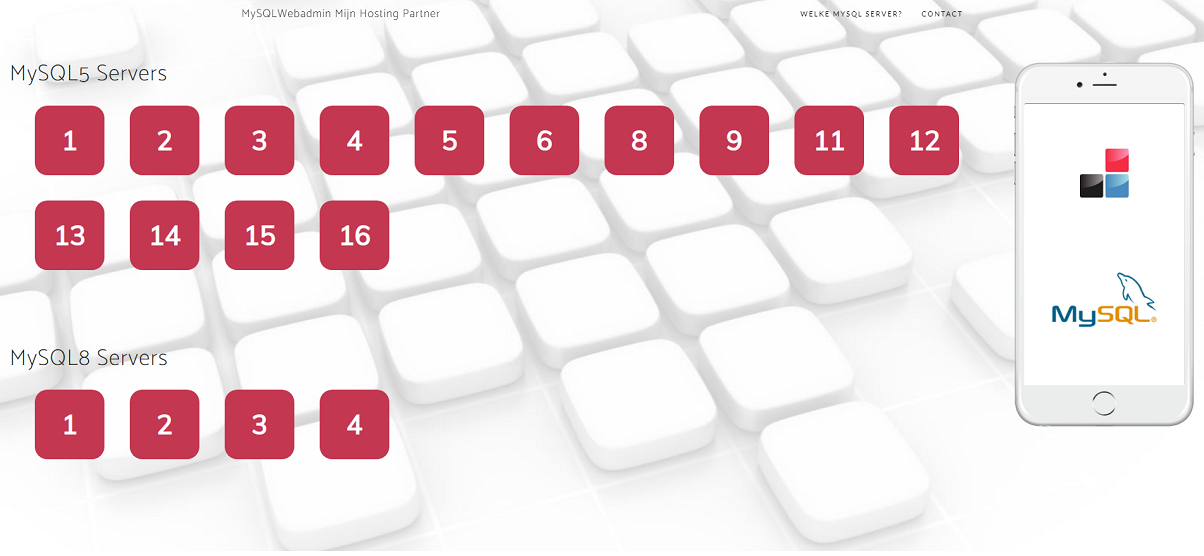MySQL 8 databases now available
MySQL is one of the most popular free-to-use solutions for storing data, the update to MySQL 8 brings a number of improvements that could make it the choice for your next website project! Let's take a look at how to create the database at MijnHostingPartner.nl, and what all has changed in the major update from MySQL 5 to MySQL 8.
What's new in MySQL 8
A lot of things are different and improved in MySQL 8, so for most projects we recommend switching to the later version, if you still have a legacy website then this will still be possible to run under MySQL 5. Let's take a quick look below at the biggest changes of MySQL 8, and how this may impact your website and way of working.
SQL Window functions, Common Table Expressions, NOWAIT and SKIP LOCKED, Descending Indexes, Grouping, Regular Expressions, Character Sets, Cost Model, and Histograms.
JSON Extended syntax, new functions, improved sorting, and partial updates. With JSON table functions you can use the SQL machinery for JSON data.
GIS Geography support. Spatial Reference Systems (SRS), as well as SRS aware spatial datatypes, spatial indexes, and spatial functions.
Reliability DDL statements have become atomic and crash safe, meta-data is stored in a single, transactional data dictionary. Powered by InnoDB!
Observability Significant enhancements to Performance Schema, Information Schema, Configuration Variables, and Error Logging.
Manageability Remote management, Undo tablespace management, and new instant DDL.
Security OpenSSL improvements, new default authentication, SQL Roles, breaking up the super privilege, password strength, and more.
Performance InnoDB is significantly better at Read/Write workloads, IO bound workloads, and high contention "hot spot" workloads. Added Resource Group feature to give users an option optimize for specific workloads on specific hardware by mapping user threads to CPUs.
Source Article from https://dev.mysql.com/blog-archive/whats-new-in-mysql-8-0-generally-available/
So the bottom line for most projects is that MySQL 8 results in the fact that your Web site can expect a performance improvement, as well as better stability than MySQL 5 can provide. MySQL 8 further works seamlessly with Content Management Systems such as WordPress, Joomla and Drupal.
Starting a new project with MySQL 8
To start a new project right away with MySQL 8 you can create a new database directly through the client panel, this can only be done through the client panel because we address the new MySQL 8 servers in a direct way. Instead of through the middle layer that is the control panel. This results in faster work through the new client panel, and also results in more direct control we can exercise over it.
To create a new database and user you can follow the article just created, you can manage these directly through PHPmyAdmin as you are used to further from MySQL 5. Or you can further manage it with your favorite local tool. Such as Microsoft Visual Studio, MySQL management Studio or SQLyog.
Transferring an existing database to MySQL 8
If you want to transfer an existing MYSQL 5 database to MySQL 8, this is possible. Your existing WordPress database or database for another CMS can in most cases be transferred without any problems. The safest way to test this out and try it with your Website is to follow the following steps.
- Step 1, first make a database backup and a backup of your website configuration files.
- Step 2, after this, make an export of your existing MySQL 5 database. This can be done simply with the quick export function.
- Step 3, create a new MySQL 8 user and database.
- Step 4, import your existing MySQL 5 database with the .sql file into the new MySQL 8 database, can be done via PHPmyAdmin or otherwise.
- Step 5, change your configuration files to the data of your new MySQL 8 database.
After this, your website will run via the new database, you can choose to delete your old MySQL 5 database right after this. But we recommend keeping it for a month or two after the switch. In the unlikely event something goes wrong, you can always go back.
Don't forget to change configuration files
Don't forget to change the configuration files The configuration files that need to be modified are located in other Content Management Systems in other places. The most commonly used one, WordPress, is located directly in the wwwroot. And can be modified via FTP or briefly via the file manager. The wp-config.php is this.
For Joomla, for example, this is the configuration.php file, due to a process that locks it, you may have to copy the content out, modify it in a new file. And then fix it. After this it is adjusted. If you do not know exactly where your configuration file is located, consult the documentation of your website technique. Then you will not be surprised.
MySQL 8 is now available for everyone who has a total package, SSD total hosting and also the .NET hosting packages. So use them now for your next project!
